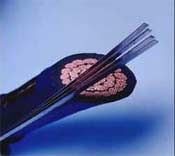 The implications of the discovery are enormous and could transform the way people live by cutting power usage from everything from refrigeration to cell phones.
The implications of the discovery are enormous and could transform the way people live by cutting power usage from everything from refrigeration to cell phones. Instead of super-cooling the material, as is necessary for conventional superconductors, the new material is instead super-compressed. The researchers claim that the new material could sidestep the cooling requirement, thereby enabling superconducting wires that work at room temperature.
"If you put hydrogen compounds under enough pressure, you can get superconductivity," said professor John Tse of the University of Saskatchewan. "These new superconductors can be operated at higher temperatures, perhaps without a refrigerant."
He performed the theoretical work with doctoral candidate Yansun Yao. The experimental confirmation was performed by researcher Mikhail Eremets at the Max Plank Institute in Germany.
The new family of superconductors are based on a hydrogen compound called "silane," which is the silicon analog of methane--combining a single silicon atom with four hydrogen atoms to form a molecular hydride. (Methane is a single carbon atom with four hydrogens).
Researchers have speculated for years that hydrogen under enough pressure would superconduct at room temperature, but have been unable to achieve the necessary conditions (hydrogen is the most difficult element to compress). The Canadian and German researchers attributed their success to adding hydrogen to a compound with silicon that reduced the amount of compression needed to achieve superconductivity.
Tse's team is currently using the Canadian Light Source synchrotron to characterize the high pressure structures of silane and other hydrides as potential superconducting materials for industrial applications as well as a storage mechanism for hydrogen fuel cells.
The research was funded by the National Sciences and Engineering Research Council of Canada, the Canada Research Chairs program, the Canada Foundation for Innovation and the Max Plank Institute.
Source: www.nextenergynews.com
No comments:
Post a Comment